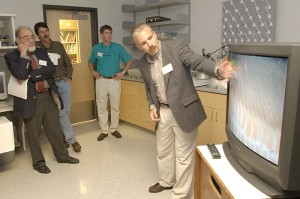
Manufactured nanomaterials can be found in such diverse applications as electronics, cosmetics, paints, and even medicines, but their effects on the environment remain largely unknown. In a new laboratory study, scientists have found that saltwater oysters and mussels take up and retain significant amounts of manufactured nanoparticles from seawater in clumps of so-called “marine snow.”
“Nanomaterials are being used in increasing amounts, and it’s likely they’re being released in increasing amounts into the environment, including the ocean,” says Evan Ward, professor of marine sciences at UConn’s Avery Point campus. “As we develop these technologies, we need to be cautious, we need to know where the particles are going, and we need to know how they affect marine organisms.”
Nanoparticles are tiny versions of common materials that have a diameter of less than 100 nanometers, or about four millionths of an inch. Their tininess gives them properties that normal-sized particles don’t have: for example, their large surface area for their size makes them stronger, lighter, and more reflective, making them ideal for reinforcing metals, increasing the SPF in your sunscreen, and producing paint that improves your home’s energy efficiency.
Some scientists, however, are concerned that these very properties could also make manufactured nanoparticles dangerous. When products break down in landfills, nanoparticles can wash away into soils, waterways, and the ocean, potentially creating hazards to animals and plants.
“Some materials that one would assume are safe can in fact cause damage to cells in their ‘nano’ form,” Ward says.
Ward studies the environmental physiology of oysters, mussels, and their relatives, which use their gills as specialized filters to take up food from ocean water. Although nanoparticles themselves are too small to be captured in large amounts, Ward’s study focused on how the bivalves’ feeding ecology affected their rate of uptake.
“In our study, we took into account how nanoparticles are likely to be delivered to the animals in the natural environment,” he says. “We asked, ‘What’s the setting in which they will be exposed to these particles?’”
Materials rarely exist as individual particles in the ocean, says Ward; instead, ocean currents bind up particles and sticky organic matter into aggregates that scientists call “marine snow.” These aggregates then sink to the bottom, where filter feeders like bivalves ingest them.
In their paper, published in Marine Environmental Research, Ward and coauthor Dustin Kach, a former UConn graduate student, used natural seawater to produce marine snow that contained fluorescently labeled polystyrene nanoparticles. They then exposed oysters and mussels collected from the Long Island Sound to this snow-filled seawater.
The researchers found that nanoparticles were taken up in much higher amounts when the bivalves were exposed to marine snow. But they also found that when filtered from marine snow, nanoparticles remained in the bivalves’ bodies for a much longer time than would be expected for non-nutritive materials: up to three days.
Ward suspects that the particles are being treated as food by the animals, and are being taken up into their digestive cells. This could be particularly dangerous, he says, since small nanoparticles can circumvent living cells’ natural defenses.
“Because of their high surface area, manufactured nanoparticles can strip off electrons from other compounds and create free radicals,” he says. “Particles like these can cause havoc in cells.”
Ward sees his work as a first step in understanding the potential issues associated with manufactured nanoparticles. He emphasizes that further work is needed to determine the amounts of manufactured nanoparticles in seawater and their levels of toxicity to living things.
“Right now there are few techniques to identify manufactured nanomaterials in the natural environment because they’re so darn small,” he says. “With these studies, we hope to demonstrate potential problems to keep in step with the use of nanomaterials. Then when techniques are available to sample them in the wild, we’ll be prepared to say whether or not we should be worried.”
Ward and his colleagues (graduate student John Doyle, professor Rob Mason, assistant professor Bryan Huey) recently received an award from the Connecticut Sea Grant College Program to continue research on nanomaterials. Their work will be part of UConn’s Interdisciplinary Research & Training Initiative on Coastal Ecosystems & Human Health (I-RICH), one of only five Traineeship Programs in the country funded by the Oceans and Human Health Initiative of the National Oceanographic and Atmospheric Administration (NOAA). I-RICH is a training and research partnership among UConn, the Mystic Aquarium, and the NOAA National Marine Fisheries Service in Milford.
Ward uses endoscopic video to record mussels using their gills to filter food particles from ocean water. In this video, food particles are radiolabeled and appear bright green:


